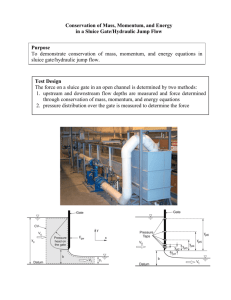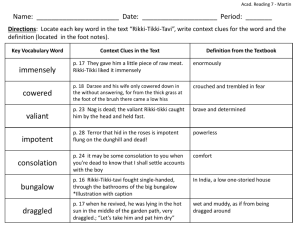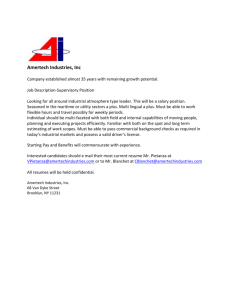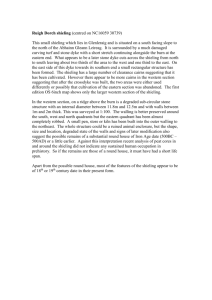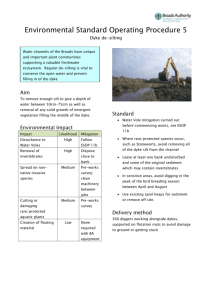7. WORK 111
advertisement
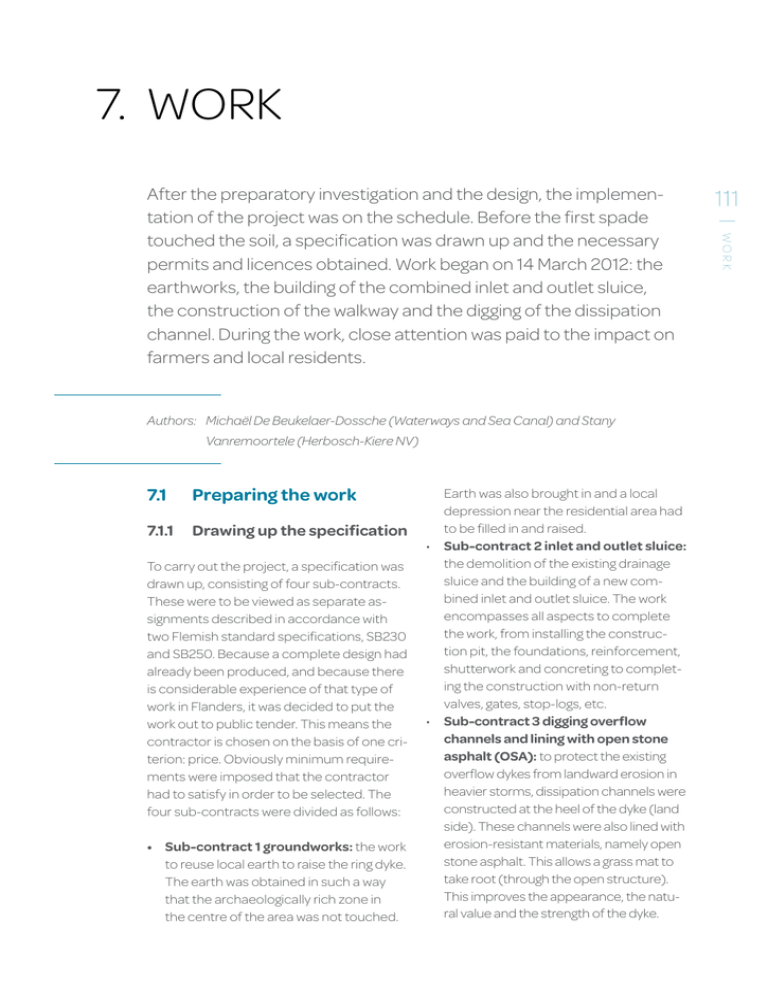
7.WORK Vanremoortele (Herbosch-Kiere NV) 7.1 Preparing the work 7.1.1 Drawing up the specification To carry out the project, a specification was drawn up, consisting of four sub-contracts. These were to be viewed as separate assignments described in accordance with two Flemish standard specifications, SB230 and SB250. Because a complete design had already been produced, and because there is considerable experience of that type of work in Flanders, it was decided to put the work out to public tender. This means the contractor is chosen on the basis of one criterion: price. Obviously minimum requirements were imposed that the contractor had to satisfy in order to be selected. The four sub-contracts were divided as follows: • Sub-contract 1 groundworks: the work to reuse local earth to raise the ring dyke. The earth was obtained in such a way that the archaeologically rich zone in the centre of the area was not touched. Earth was also brought in and a local depression near the residential area had to be filled in and raised. • Sub-contract 2 inlet and outlet sluice: the demolition of the existing drainage sluice and the building of a new combined inlet and outlet sluice. The work encompasses all aspects to complete the work, from installing the construction pit, the foundations, reinforcement, shutterwork and concreting to completing the construction with non-return valves, gates, stop-logs, etc. • Sub-contract 3 digging overflow channels and lining with open stone asphalt (OSA): to protect the existing overflow dykes from landward erosion in heavier storms, dissipation channels were constructed at the heel of the dyke (land side). These channels were also lined with erosion-resistant materials, namely open stone asphalt. This allows a grass mat to take root (through the open structure). This improves the appearance, the natural value and the strength of the dyke. WORK Authors: Michaël De Beukelaer-Dossche (Waterways and Sea Canal) and Stany 111 | After the preparatory investigation and the design, the implementation of the project was on the schedule. Before the first spade touched the soil, a specification was drawn up and the necessary permits and licences obtained. Work began on 14 March 2012: the earthworks, the building of the combined inlet and outlet sluice, the construction of the walkway and the digging of the dissipation channel. During the work, close attention was paid to the impact on farmers and local residents. 112 | WORK • Sub-contract 4 building a walkway: to guarantee public support, the educational function and recreational use, a comfortable walking path is being built through the nature area, with views of the unique inlet and outlet sluice. The path is made from FSC (Forest Stewardship Council) wood. To allow as much competition as possible, the contract was published throughout Europe for 52 days. Finally, seven offers were received from contractors, three of which were chosen for assessment. Of these bids, the submission of Herbosch-Kiere NV offered the best value. 7.1.2 Permission to start work The following were required so that work could actually start: • An urban development permit: the Flemish Government issued this permit, thereby granting permission to carry out the work described in the plans. The permit refers to the project EIA (environmental impact assessment) and other advice, such as that regarding the archaeological survey. The permit was obtained on 4 February 2011. • Authorisation to begin work on the sites: because not all the sites in the area were owned or managed by Waterways and Sea Canal, use had to be made of the Flemish Parliament Act on Flood Defences. This provides for authorisation to carry out work – for infrastructure of public interest and to protect the population – on third-party land. The authorisation was signed by the competent minister. Authorisation was obtained on 4 November 2011. Work finally began on 14 March 2012, after a start-up meeting had been held for local residents and stakeholders. This took place in the presence of the contractor, the engineering firm, the Purchasing Committee carrying out the expropriations and the Flemish Land Company (VLM), which supports farmers during expropriations, and the client. During and after the presentations, those present could put questions to the representatives. A leaflet was also handed out in the area. Dozens more questions and comments were answered by telephone and e-mail. 7.2 Carrying out the work 7.2.1Earthworks Protection against flooding is the primary objective of the updated Sigma Plan. Work therefore began with the ring dyke. This ring dyke had to be raised and widened. The removal of plant growth was the first step. Access roads to the area were closed and a site hut erected next to the area. The contractor chose not to provide any additional protection against flooding during the work on top of the relatively low overflow dykes. A pilot level was therefore set at +6 m TAW with Flanders Hydraulics Research and Waterways and Sea Canal (approximately 40 cm below the crest of the overflow dyke). The predictive model used could then warn three days in advance when the waterlevel reached more than +6 m TAW. The site management was then automatically notified by text message. Figure 7.2. Earthworks: raising and widening the ring dyke Figure 7.3. Earthworks: end of excavating the channel source In addition to this work, in sub-contract 1 the depression by the residential area also had to be filled in. The contractor chose to do this using the material from the channel source to be excavated around the archaeological island. This choice had to do with the high groundwater level and the lower quality of the material from a soil-mechanics point of view (a heterogeneous mixture of peat and heavy soil). Extra operations to reuse the material expertly as a covering material on the primary flood defence were thus avoided. In net terms, the following materials were used: • supply of core material, • supply of heavy soil, • reuse of heavy soil from the excavation, • quarry stone, • grass seed. WORK To carry out the earthworks and site profiling correctly, the cranes and bulldozers were given a 3D map. This was linked to the GPS in the equipment. 113 | Figure 7.1. Earthworks: start of excavating the channel source The dyke was constructed according to a number of steps: • stripping the turf from the dyke, • removing the covering layer in heavy soil, • reprofiling and compacting the raised core of the dyke, • applying heavy soil, • applying dyke strengthening to the toe of the dyke with quarry stone (to counter washout), • applying sub-foundations and foundations for the towpath, • creating a semi-metalled towpath (mixture of rubble and soil), • seeding the towpath and the sides of the dyke with an ecological grass mixture. 114 | WORK The contractor used these machines at the same time: • Hitachi 350 crane, • Liebherr 925 Long Reach crane (finishing), • Caterpillar D6 bulldozer, • Volvo D25 dumpers, • 40 tonne trucks, • steamroller, • etc. The dyke was constructed in phases, but with a significant overlap between the various phases. Because machines were continuously used, time was saved and efficiency increased. 7.2.2 Combined inlet and outlet sluice At the same time as modifying the existing dyke, work began to demolish the existing sluice in order to avoid the stormy season between October and February. If the work started in the spring, by October no further inconvenience would be caused by the operation of the existing FCA. The FCA currently has the chance of becoming operational from 1 to 2 fills a year. This approach also benefited the manager Waterways and Sea Canal and the Agency for Nature and Forest (ANB), as it allowed a finished safety and nature area to be implemented more quickly. A sheet pile wall was first built as a construction pit for the work. Based on the calculations of the contractor the piles were driven in. Once the river side of the construction pit was ready, however, it emerged while demolishing the sluice that an older sluice was present in the dyke, partly beneath, partly alongside the existing sluice. This made demolition much more difficult. In addition, the condition of the ground in the layers between +0 m and -5 m TAW did not appear to correspond fully with the analysis of the cone penetration tests. For example, the expected continuous layers of clay were not continuous, which meant it was not possible to seal the construction pit. This resulted in a construction pit where a “breakdown” occurred along the bottom on the river side. As a result, the pit could not be pumped dry and the sheet pile wall became distorted. Both the municipality and the Agency for Nature and Forest were notified of these problems. The best solution was subsequently sought in consultation with the contractor and the design office. These solutions were considered: 1. Modify the existing construction pit (deeper pile frame reinforcement): this option did not appear viable due to the extra cost. Thus, the existing sheet piles were inadequate, with the result that longer and heavier sheet piles were needed. In addition to the cost, this solution also meant a major delay, because the sheet piles could only be delivered after approximately three months. 2. Move the sluice further up on the overflow dyke: this option would reduce the demolition work on the existing sluices. However, a real risk would remain of similar problems for breakdown, despite a marginally better stratification. To be certain of this, extra cone penetration tests were required. The cost and time of additional sheet piles also had to be factored in for this solution. Finally the third option was chosen. Once work had begun to build the new sluice, the municipal authorities rightly asked whether that did not imply a change to the work as provided for in the urban development permit. Because the structure had been moved by around 30 m, an additional urban development permit was applied for. This was quickly obtained thanks to the involvement of the municipality, local residents and the ANB in the project. To prevent erosion, a dissipation channel was dug. The channel was lined with open stone asphalt and a layer of topsoil, which was then sown. This means the energy of flooding water is broken up in a dissipation channel. In the winter following construction the flood area became operational, as a result of which the topsoil was washed away and the open stone asphalt was slightly damaged. In the end, therefore, no construction pit was needed to build the sluice itself. This improved the safety and accessibility of the sluice. The following materials were needed to build the sluice: • 600 m3 of concrete, • 67,800 kg of reinforcing steel, • 79,000 kg of steel sheet piles, • 6 non-return valves, • 12 HDPE gates with rubber seals, • 24 gratings, • aluminium stop-logs. The following machines were used to build the sluice: • Sumitomo cable crane, • trucks and concrete mixers for the supply of materials. 7.2.3 Constructing the dissipation channel Investigations revealed, however, that the damage was in fact to the overflow dyke (built in the 1980s) and not to the newly constructed layer. To apply the open stone asphalt to the same thickness, a steel frame was used that is equal to the profile of the channel. 7.2.4 A recreational walkway As described above, a wooden walkway was constructed through the area. The walkway was built in various phases. Firstly, foundation piles were driven in every 32 m to establish the route. Next, 2 rows of foundation piles 3 m apart were driven in every 2 m. Then the substructure was installed, and following checks by the contractor it was decided to install two additional supporting beams underneath the wooden floor to limit sagging. 115 WORK A permanent team of concrete pourers (6 people), a pile-driving team (3 people) and a team of steel fixers (4 people) worked on the construction of the sluice. | 3. Build the new sluice on the land side and then free up a link to the Scheldt afterwards by locally moving the overflow dyke: this solution required only a limited construction pit, which was more beneficial. It also enhanced planning and time management by a fair amount. 116 | WORK To reduce production costs, the contractor opted for prefabricated walkway modules in Kallo. The modules measured 3 x 3 m and could easily be installed in situ. After the walkway had been assembled, the planks appeared to sag more than expected on the basis of the calculations. To prevent the planks from breaking at a later point in time, the contractor ultimately installed a second layer of planks. The extra supporting beams and the additional layer of planks were unscheduled work and to be charged in addition to the tender amount. The following materials were used to build the walkway: • wooden piles with a diameter of 22 cm and length of 4 m (walkway) and 6 m (bridge over channel source), • beam-supporting structure, • 2 layers of grooved planks 2 cm thick. These machines were used to build the walkway: • crane, • trucks for the supply of materials. These teams worked on building the walkway: • fixed team for assembly (2 people), • pile-driving team for the wooden piles (3 people). SCH ELD T Modification with regard to the permitted situation ref.SV.BP/4276/464gs dated 04.02.2011 For the inflow and outflow construction, see plan C9373-B13w to B19w Quarry stone layer, thickness = 0.50 m Figure 7.4. The altered location of the sluice Photo report of the progress of the construction of the sluice 117 | Figure 7.6. Floor slab and sheet piles against seepage Figure 7.7. Concreting the walls Figure 7.8. Formwork and reinforcement of the intermediate plate of the inlet and outlet Figure 7.9. Formwork and reinforcement of the superstructure Figure 7.10. Installation of the framework infrastructure Figure 7.11. Finished sluice WORK Figure 7.5. Formwork and reinforcement of the walls 118 7.3 Public support | WORK While the alteration work was being carried out, use was made of the flanking agricultural policy. For example, arrangements were made with farmers who wanted to continue using their agricultural plots in the work zone. In consultation with the contractor, plots were selected where that was possible. These were plots that were not affected by the actual construction work. The advantage was that the area was maintained even during the work at no extra cost, while the farmers were able to benefit from one or two extra mowings. Figure 7.12. Construction of dissipation channel with open stone asphalt To guarantee safety, arrangements are in place regarding transports by the contractor and those of the farmers. These arrangements were formalised in revocable agreements between Waterways and Sea Canal and the farmers. Local residents also received due attention. During periods of sunny weather ground particles could fly upwards, creating a dust nuisance for local residents in their adjoining gardens. To limit this dust nuisance, the contractor imposed strict speed limits on drivers. During rainy weather on the other hand, the ground became muddy as a result of the earth carried by trucks around the site all the way on to the public roads. So regular cleaning was carried out by a specialist company in consultation with the municipality. Figure 7.13. Start of the walkway Figure 7.14. A completed FCA-CRT WORK • Standard Specification 260 / www.vlaanderen.be/nl/ publicaties/detail/standaardbestek-260-voorkunstwerken-en-waterbouw • Standard Specification 250 / www.wegenenverkeer.be/ standaard-bestek-250 • Herbosch-Kiere NV / www.herbosch-kiere.be • Tractebel Engineering / www.tractebel-engineeringgdfsuez.com 119 | 7.4 References
